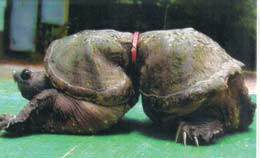
One of the things we’ve been avoiding in the No Impact project is plastic. No plastic bags, bottles, tubs, wrappings, toys, gadgets, clothes, buttons, pipes, plates, cups, forks, spoons, knives, toothpaste tubes, shampoo bottles, dish soap bottles. In other words, just about everything. I’m old enough to remember a time before plastic became so ubiquitous, when people avoided plastic goods as junk. But now it’s everywhere, and you can even find ads claiming that a product is made from the “highest quality plastic.” What an oxymoron!
Anyway, two kind No Impact Man readers separately emailed me an article from Best Life Magazine by Susan Casey entitled “Plastic Ocean.” The photos are by Gregg Segal. His photo here shows a turtle deformed by a plastic band that the turtle got tangled in when it was young. Here are some clips from the article:
“A vast swath of the Pacific, twice the size of Texas, is full of a plastic stew that is entering the food chain. Scientists say these toxins are causing obesity, infertility…and worse.”
“Except for the small amount that’s been incinerated—and it’s a very small amount—every bit of plastic ever made still exists.”
“Some of the most obvious victims are the dead seabirds that have been washing ashore in startling numbers, their bodies packed with plastic: things like bottle caps, cigarette lighters, tampon applicators, and colored scraps that, to a foraging bird, resemble baitfish. (One animal dissected by Dutch researchers contained 1,603 pieces of plastic.)”
“More than a million seabirds, 100,000 marine mammals, and countless fish die in the North Pacific each year, either from mistakenly eating this junk or from being ensnared in it and drowning.”
“The more invisible and ubiquitous the pollution, the more likely it will end up inside us. And there’s growing—and disturbing—proof that we’re ingesting plastic toxins constantly, and that even slight doses of these substances can severely disrupt gene activity.”
“Fertility rates have been declining for quite some time now, and exposure to synthetic estrogen—especially from the chemicals found in plastic products—can have an adverse effect,” says Marc Goldstein, M.D., director of the Cornell Institute for Reproductive Medicine. Dr. Goldstein also notes that pregnant women are particularly vulnerable: “Prenatal exposure, even in very low doses, can cause irreversible damage in an unborn baby’s reproductive organs.”
“Of the seven different plastics in common use, only two of them—PET (labeled with #1 inside the triangle and used in soda bottles) and HDPE (labeled with #2 inside the triangle and used in milk jugs)—have much of an aftermarket. So no matter how virtuously you toss your chip bags and shampoo bottles into your blue bin, few of them will escape the landfill—only 3 to 5 percent of plastics are recycled in any way.”
To read the whole, horrifying article, go here.